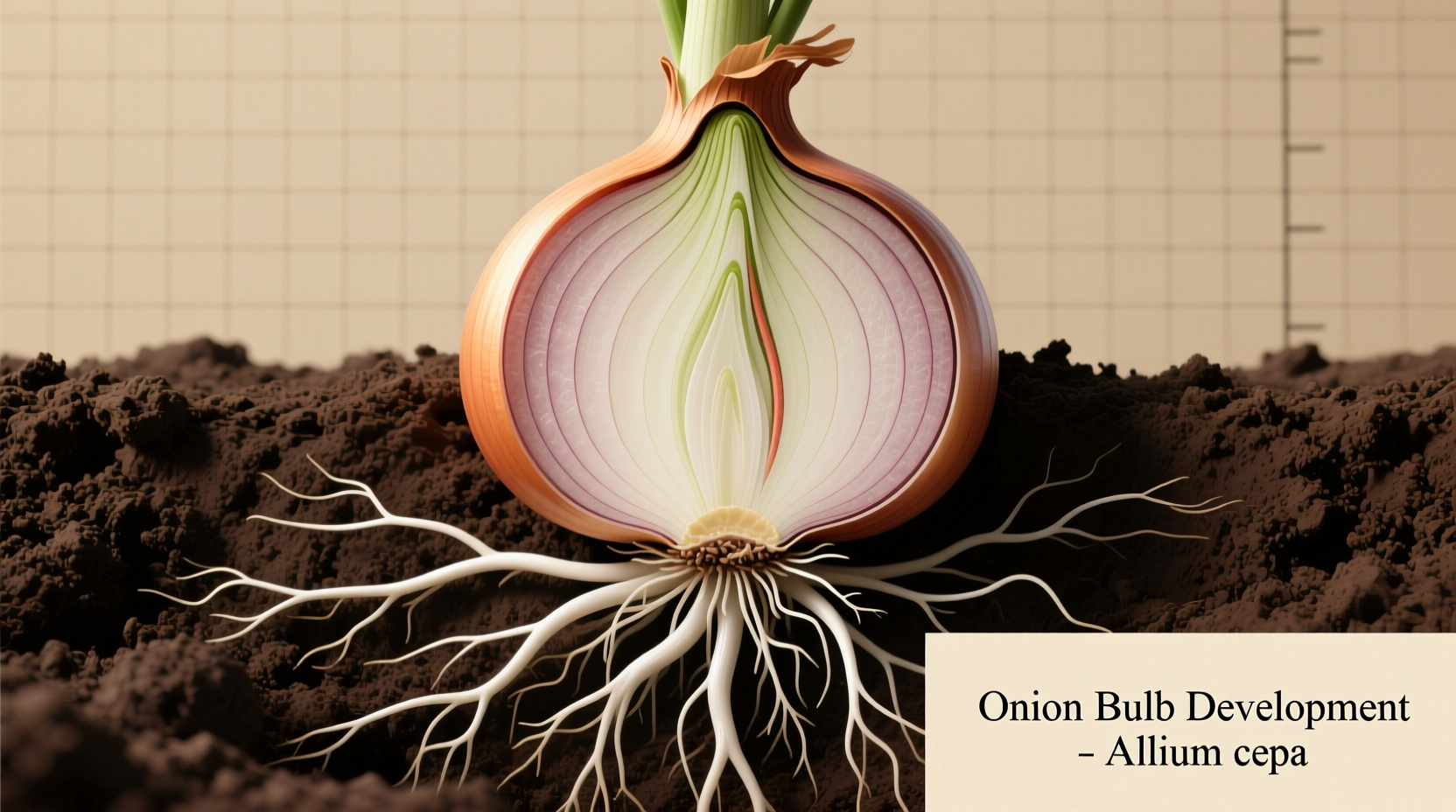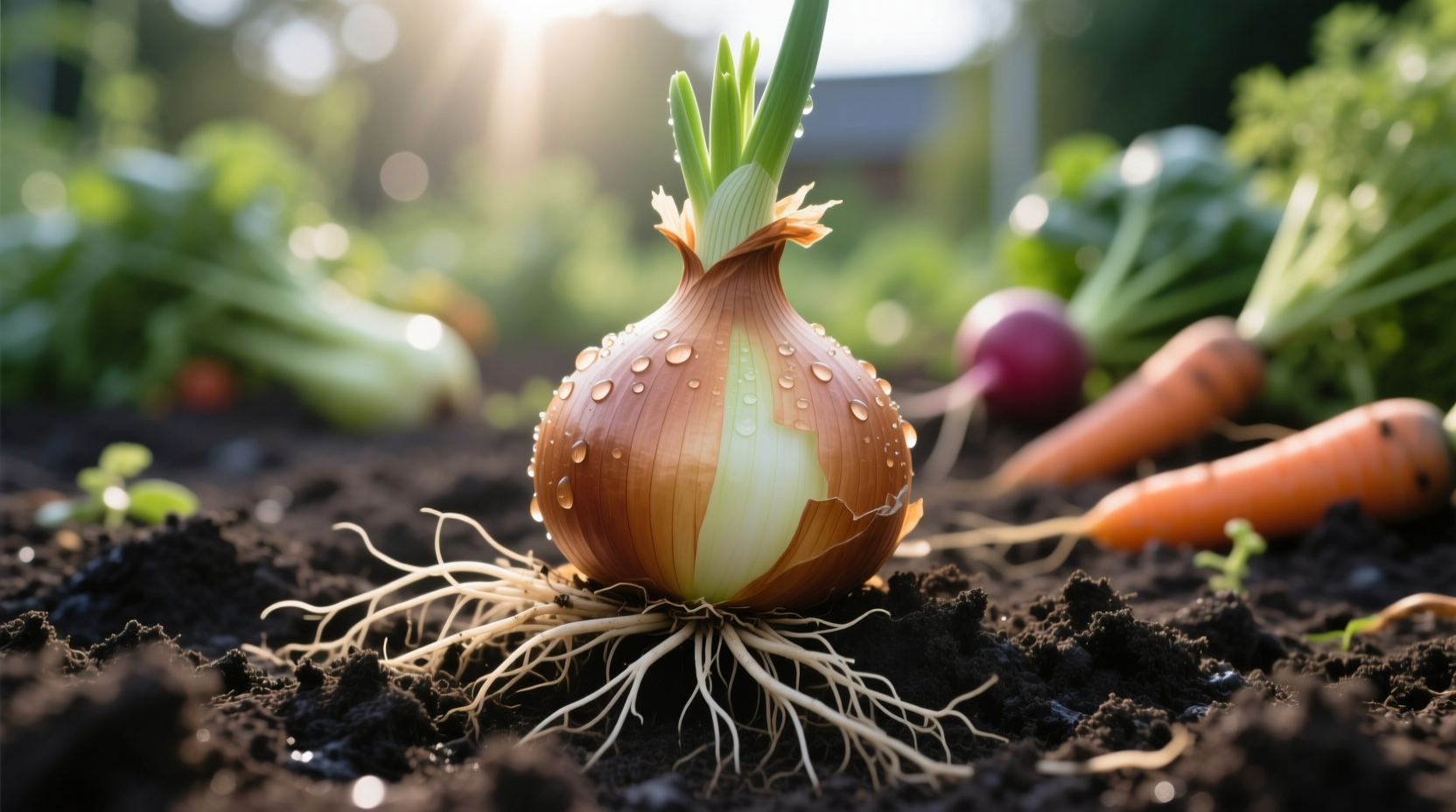Understanding how onions grow is essential for both home gardeners and culinary enthusiasts. Despite their common presence in kitchens worldwide, the growth process of onions remains misunderstood by many. Let's explore the fascinating journey of how this versatile vegetable develops from seed to harvest-ready bulb.
How Onions Actually Grow: The Complete Growth Cycle
Onions (Allium cepa) follow a specific growth pattern that combines both underground and above-ground development. The bulb—the part we eat—forms beneath the soil surface through a process called bulbing. As the plant matures, the base of the stem swells, storing nutrients that create the layered structure characteristic of onions.
During the first growing season, onion plants focus energy on developing their root system and green tops. As daylight hours increase in spring and summer, the plant receives signals to begin bulb formation. This photoperiod-sensitive process causes the stem to thicken and form concentric layers that eventually become the mature bulb.
| Growth Stage | Timeframe | Key Development |
|---|---|---|
| Germination | 7-14 days | Roots establish, first green shoot emerges |
| Leaf Development | 4-6 weeks | Green tops grow, energy builds in stem base |
| Bulb Initiation | 6-8 weeks | Stem base begins swelling, first bulb layers form |
| Bulb Maturation | 8-12 weeks | Bulb expands, outer layers dry and form protective skin |
| Harvest Ready | 12-16 weeks | Top leaves fall over, bulb reaches full size |
Common Misconceptions About Onion Growth
Many people confuse onions with other allium varieties or root vegetables. Unlike potatoes (which are tubers) or carrots (true roots), onions are modified stem tissue that stores nutrients. The Royal Horticultural Society confirms that "onion bulbs develop from the base of the leaf sheaths, not from root tissue" (RHS, 2023).
Another frequent misunderstanding involves the green tops. While the bulb grows underground, the hollow green leaves (scapes) grow above ground and continue photosynthesis throughout the growing season. These tops actually feed the developing bulb below the surface.

Optimal Conditions for Growing Onions
Successful onion cultivation depends on several environmental factors. According to the USDA Agricultural Research Service, onions require:
- Well-drained soil with pH between 6.0-7.5
- Consistent moisture during bulb formation
- Full sun exposure (at least 6 hours daily)
- Proper spacing (4-6 inches between plants)
Interestingly, different onion varieties respond to varying day lengths. Short-day onions (ideal for southern regions) begin bulbing when days reach 10-12 hours, while long-day varieties (better for northern climates) require 14-16 hours of daylight. This photoperiod sensitivity explains why some gardeners experience poor bulb development—their variety doesn't match their local daylight patterns.
Practical Tips for Home Gardeners
Whether you're planting onion sets, seeds, or transplants, follow these evidence-based practices for optimal results:
- Soil preparation: Amend soil with compost before planting to improve drainage
- Planting depth: Set onion bulbs at 1-inch depth with root plate facing down
- Water management: Provide 1 inch of water weekly, increasing during bulb formation
- Fertilization: Use balanced fertilizer early, then switch to high-phosphorus formula
- Weed control: Hand-pull weeds carefully to avoid damaging shallow roots
Cornell University's Cooperative Extension notes that "onions have shallow root systems that cannot compete well with weeds, making regular weeding essential for proper bulb development" (Cornell, 2022). This explains why many home gardeners struggle with small bulb sizes—their plants are competing for nutrients.
Harvesting and Curing Onions Properly
Knowing when and how to harvest makes a significant difference in storage life. Watch for these maturity indicators:
- Top leaves begin to yellow and fall over naturally
- Neck of the plant becomes soft and begins to collapse
- Bulb skins turn dry and papery
When harvesting, gently lift bulbs from soil and allow them to cure in a warm, dry location with good air circulation for 2-3 weeks. Properly cured onions can store for 6-8 months under ideal conditions (32-40°F with 65-70% humidity).
Troubleshooting Common Onion Growing Problems
Even experienced gardeners encounter challenges with onion cultivation. Here are solutions to frequent issues:
- Small bulbs: Usually caused by overcrowding, poor soil nutrition, or wrong variety for your region
- Thick necks: Results from excessive nitrogen late in season or pest damage
- Split bulbs: Often due to irregular watering during bulb formation
- Premature flowering: Caused by temperature fluctuations or planting oversized sets
Understanding these growth patterns helps explain why proper planting timing matters. In most regions, onions should be planted 4-6 weeks before the last expected frost date for optimal bulb development.
Frequently Asked Questions
Can onions grow completely above ground?
No, onions cannot develop proper bulbs without growing underground. While the green tops grow above ground, the bulb formation requires soil coverage. If bulbs become exposed due to erosion or shallow planting, they may become misshapen or fail to develop fully.
How deep do onion roots grow?
Onion roots typically grow 12-18 inches deep but remain relatively shallow compared to other vegetables. The majority of the root system develops in the top 6-8 inches of soil, which is why consistent moisture and weed control are crucial for healthy bulb development.
Why do my onion plants keep falling over?
Onion tops naturally fall over when bulbs reach maturity, signaling harvest time. However, premature falling can indicate overwatering, nutrient imbalance, or pest damage. If plants fall over before bulbs have properly formed, check for thrips infestation or excessive nitrogen in the soil.
Can you grow onions in containers?
Yes, onions grow well in containers with proper depth (at least 8 inches) and drainage. Use a quality potting mix and ensure containers receive full sun. Container-grown onions require more frequent watering but can produce excellent bulbs when given adequate space (one onion per 4-inch diameter container).
How long does it take for onions to grow from seed?
Onions grown from seed typically take 100-175 days to reach maturity, depending on variety and growing conditions. Sets (small pre-grown bulbs) mature faster, usually in 70-100 days. Daylength requirements significantly impact maturity timing, with short-day varieties maturing earlier in southern regions.











 浙公网安备
33010002000092号
浙公网安备
33010002000092号 浙B2-20120091-4
浙B2-20120091-4